Sep
1
2012
Bulls and Basins
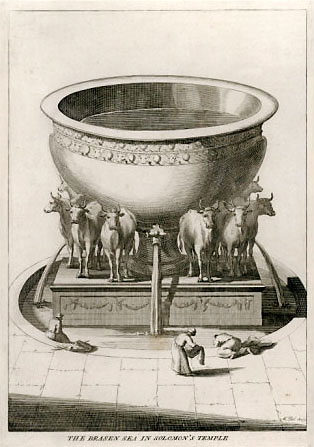
“You are beautiful as Tirzah, my love, lovely as Jerusalem, awesome as an army with banners.” (Songs 6:4)
An online friend recently questioned the repetition found in Numbers 7. The offerings of each tribe are identical, yet each is listed in full. Surely, this was a waste of expensive parchment? Architecture is important to God, no less literary architecture, and it seems to me that the “fullness” of the Offertory in chapter 7 is the result—or the liturgical response, to the military “forming” of Israel in chapter 2.
Continue reading
Comments Off | tags: Covenant curse, Covenant Theology, Laver, Literary Structure, Nazirite, Numbers, Numbers 5, Tabernacle | posted in Bible Matrix, Biblical Theology
Mar
5
2012
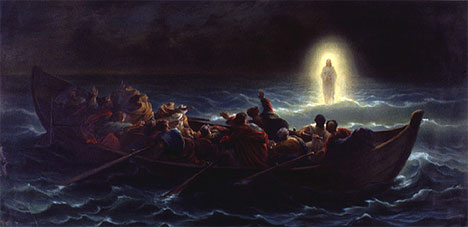
“…and they saw the God of Israel. And there was under His feet as it were a paved work of sapphire stone, and it was like the very heavens in its clarity. But on the nobles of the children of Israel He did not lay His hand.” (Exodus 24:10-11)
Well, I’ve been blustering on about art and “intuition” in generalities for about a week now. Fluffy generalities are exactly the kind of thing that annoys me about many Biblical scholars, and I reckon it annoys God, too. They never seem to get down to specifics, and He is very specific. This shows in His architecture, and also in His literary architecture. So, here, in a section of Matthew 14, is a chance for me to get specific and show you what is possible with this “killer hermeneutic.” [1]
After a brief look at the structure of this passage the other day, I thought I’d spend some more time on it. A closer analysis has revealed an even greater beauty than I expected. (I have briefly referenced the order of words in the Greek to avoid any great missteps, so it may not be perfect, but it’s close.) Much learning hath indeed made me mad but I hope you’ll take a few minutes to see this passage through my eyes.
Continue reading
Comments Off | tags: Atonement, Booths, Covenant curse, Covenant Theology, Feasts, High Priest, Laver, Literary Structure, Matthew, Moses, Tabernacle, Ten Commandments | posted in Against Hyperpreterism, Bible Matrix, Biblical Theology, The Last Days
Feb
21
2012
or The New Jerusalem has a Moat

“I know your works: you are neither cold nor hot.
Would that you were either cold or hot!” (Revelation 3:15)
The world is a cosmic Tabernacle. The first domain of Mediatory Man was between the waters. The waters below (springs) were necessary for life but they were not “a place to live.” The waters above did likewise. However, these were temporary veils, boundaries to be crossed in an increasing advance-by-faith.
Continue reading
Comments Off | tags: Creation Week, Crystal Sea, Genesis, Laver, New Jerusalem, Noah, Revelation, Tabernacle, The flood | posted in Bible Matrix, Biblical Theology, Creation, The Last Days
Jun
17
2011
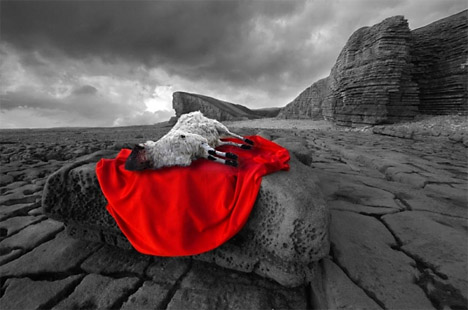
Doug Wilson writes:
“It is of course true that real religion is concerned with the state of the heart, and not with whether a man has jumped through all the right ceremonial hoops. When a man believes the covenant promise he points away from himself . . . To look away from the heart to an objective Christ is not to neglect the heart; to look away in this fashion is the only way to be justified and put right with God” (To a Thousand Generations, p. 46).
This is an excellent statement. It’s perfect fruit for a pie but Pastor Wilson is sticking it in a casserole.
Continue reading
15 comments | tags: Baptism, Circumcision, Covenant Theology, Doug Wilson, Federal Vision, Laver, Tabernacle, Typology | posted in Biblical Theology, Quotes
Mar
24
2011

“And thou shalt set bounds unto the people round about, saying,
Take heed to yourselves, that ye go not up into the mount,
or touch the border of it:
whosoever toucheth the mount shall be surely put to death.”
Exodus 19:12
The Bible beats blood and water into us over and over again. Blood is death. Water is resurrection. Blood is the Bridegroom and water is the Bride.
Continue reading
5 comments | tags: Ascension, David, goliath, Laver, Moses, Revelation, Sinai, Tabernacle | posted in Bible Matrix, Biblical Theology, Creation, Totus Christus
Aug
9
2010
An Exhortation to Be A Fruitful Tree
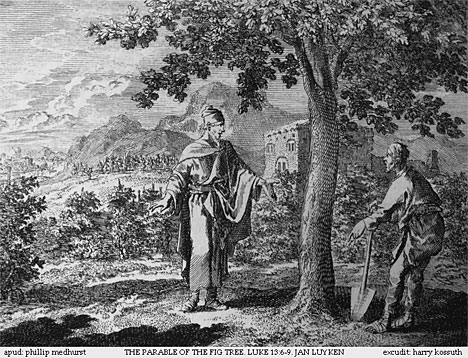
Tabernacles was the final annual feast, a Godfest to be thrown by Jews as a ministry to Gentiles. At the Feast of Clouds [1], every household temporarily became a new house of God, a “local branch” of the Tabernacle, a “priesthood of all believers.” Of course, we see this fulfilled in the book of Acts. Just as we see Paul exhort the Ephesians (Gentiles!) to put on the mediatorial body-armour of the High Priest, [2] his final exhortation to the Roman Christians alludes to not only Israel’s feasts but Israel’s priesthood. Pretty much every church he established was a “booth” made of natural Jewish branches and ingrafted Gentile branches. [3] At Pentecost, the same cloud that received Jesus filled the house. [4] Now every household of faith was a Tabernacle, a glorious cloud with a government of human angel-elders. [5] In the Bible’s literary structure, a recurring motif at Tabernacles is good fruit, godly offspring. God wants more than just a covering of leaves. As in Eden, future generations hang upon wise government.
Continue reading
8 comments | tags: AD70, Add new tag, Atonement, Doug Wilson, Feasts, Genesis, Laver, Literary Structure, Paul, Roman Catholicism, Romans, Systematic typology, Tabernacles, Temple | posted in Bible Matrix, Biblical Theology, The Last Days
Nov
24
2009
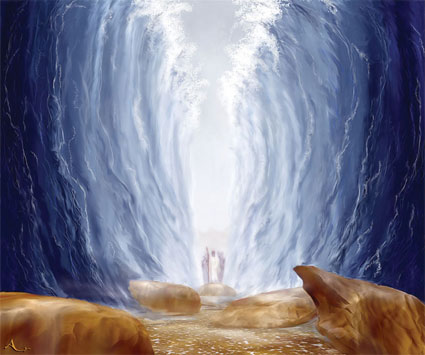
There was a discussion of purgatory on the BH list. Someone summarised it as follows: [1]
“Or, perhaps, with Peter Kreeft, one might interpret purgatorial cleansing as a form of heightened and perfected awareness, effected by the light of God’s presence as an illuminating and purifying fire. Thus, in death, in coming face-to-face with God, we finally see ourselves as we truly are, the depths of our own sin and brokenness, and all the consequences and ruin wrought by our own sin and unfaithfulness in our own lives, the lives of others, and the ongoing life of our family, church, and world.
Continue reading
Comments Off | tags: Atonement, Azal, Baptism, Communion, Crystal Sea, Laver, Purgatory, Roman Catholicism | posted in Biblical Theology, Quotes
Sep
25
2009

Today we had our final “Scripture” class at the high school for this term. After a summary of the term’s lessons and a final gospel presentation, students were asked to fill out a form and tick some boxes. It was encouraging to see how many students ticked the “I made a decision for God today” box (or words to that effect). And which kids tick that box is always very surprising. God is at work.
Which left us to decide what to do next term. We can’t just do the basics again (and believe me, the lessons we are doing now are kindy stuff). I suggested we challenge those who made decisions to join a church and get baptized. Look of horror from the Anglican teacher.
Continue reading
2 comments | tags: Baptism, Bible Matrix, Federal Vision, Gnosticism, Laver, Revelation | posted in Christian Life
Apr
16
2009
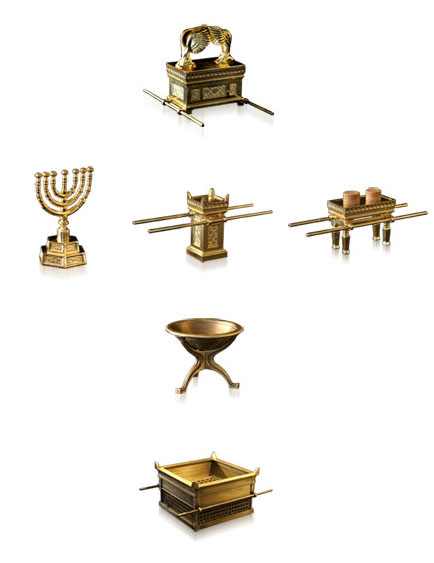
The Tabernacle was not only a “portable Sinai”, the mountain of God laid out across the ground, it was the cruciform Man. We see Jesus, with the Throne of God on His shoulders (the Ark – government), bread and wine in His left hand (the Table - servanthood), the ‘seven stars’ of the Lampstand in His right (dominion), and His feet on the crystal sea (the Laver – resurrection). And He is lifted up “in the air” between heaven and earth (the Altar-Land) as the Mediator Who unites God and man.
As the Ark (Moses), with arms outstretched (Bread – Aaron, and Ruling Lights – Hur), He is the prophet, priest and king Who defeated Greater Amalek at Sinai.
Comments Off | tags: Amalek, Ark of the Covenant, Lamps, Laver, Moses, Revelation, Sinai, Tabernacle, Table of Showbread | posted in Biblical Theology
Apr
8
2009
Both the Red Sea and Jordan were doors of water and blood. They were two-edged flaming swords at the doorway to God.
As God’s bouncers, the Levites carried swords to keep non-priests out of the Holy Place. In the New Covenant, the Laver has been replaced by baptism. The waters of baptism are a doorway into the city of God, the ‘crystal’ walls of water standing up by the breath of God, and Christian elders are the new Levites at the twelve gates.
This means that the church can’t just accept everyone into membership. Nehemiah kicked Tobiah out of the Temple rooms but most modern churches would offer him a place on the worship team. The church, as a city with crystal walls, must be transparent so the world can see the enthroned Christ at her centre.
First century Israel muddied the waters by tolerating compromise. Pluralism and relativism can be traced back to the church of God. It’s the church’s fault. Secular humanism is just a perversion of Christianity.
Peter Leithart writes:
“The climax of the prophetic denunciation of the merchandising of Babylon in Revelation 18 is the judgment that Babylon/Jerusalem has “deceived” the nations “by your sorcery” (18:23). This is immediately followed by the charge that “in her was found all the blood of prophets and of saints and of all who have been slain on the earth” (18:24). Thus, the deceived people of the land become deceivers for the whole world. Sound familiar? Liberal churchmen deceive the nations into an ideology of tolerance and pluralism.”1
Babylon never changes. She tolerates everything, and kills anyone who disagrees. My point is, she is always a corruption of the true worship, a mediator gone bad, a narrow door made wide.
1 Deceiving the Nations, www.leithart.com
Comments Off | tags: Babylon, Baptism, Compromise, Laver, Nehemiah, Peter Leithart, Satan | posted in Biblical Theology


































